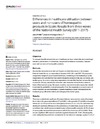Please use this identifier to cite or link to this item:
https://accedacris.ulpgc.es/jspui/handle/10553/63292
| Title: | Differences in healthcare utilisation between users and non-users of homeopathic products in Spain: Results from three waves of the National Health Survey (2011-2017) | Authors: | Pinilla Domínguez, Jaime Rodríguez Caro, Alejandro Manuel |
UNESCO Clasification: | 531207 Sanidad | Keywords: | Propensity Score Complementary Medicine Europe |
Issue Date: | 2019 | Journal: | PLoS ONE | Abstract: | Objective: To compare the differences in the use of healthcare services: visits to the doctor and hospitalisation, performance of routine tests, and preventive influenza vaccination, between users and non-users of homeopathic products. Methods: We used the microdata for adults over 15 years old from three waves of the Spanish National Health Survey, corresponding to the years 2011, 2014 and 2017. We proposed a comparative design of a quasi-experimental type, considering as the treatment group the respondents who said that they had used homeopathic products in the past two weeks; and another group, for control, comprising respondents who said that they had not used this type of products, but only conventional medicines, with observable characteristics similar to those of the treatment group. We used a model for rare events logistics regression (relogit) to estimate the probability of using homeopathy. From the propensity score and a vector of control variables, we used techniques of genetic matching to match individuals from the treatment group with similar individuals belonging to the control group. Results: There are no statistically significant differences between users and non-users of homeopathy in visits to the general practitioner (P>|z| 0.387), to the specialist (P>|z| 0.52), in hospitalisations (P>|z| 0.592) or in the use of emergency services (P>|z| 0.109). Nor were there any statistically significant differences in the performance of routine tests, except for the faecal occult blood test, which is more prevalent in users of homeopathic products. 20.9% of users of homeopathy had done this test compared with 15.3% of non-users (P>|z| 0.022). There are also significant differences in vaccination against influenza with 12.6% of homeopathy users stating that they had been vaccinated in the last influenza campaign, against 21.0% of non-users (P>|z| <0.001). The health conditions which homeopathy users reported were constipation (OR: 1.65 CI: 1.16–2.36), malignant tumour (OR: 1.60 CI: 1.09–2.36) osteoporosis (OR: 1.49 CI: 1.05–2.10), varicose veins (OR: 1.35 CI: 1.05–1.74) and allergy (OR: 1.35 CI: 1.06–1.72). Conclusions: Differences in the use of healthcare resources between users and non-users of homeopathic products have not been found to be statistically significant in Spain. It has been shown that most homeopathic products are used as a complement to treatment with conventional medicine. Nevertheless, our results highlight some warning signs which should raise the attention of healthcare authorities. The use of these therapies in patients with malignant tumours and the rejection of vaccines are warning signs of a possible health hazard in the long term. | URI: | https://accedacris.ulpgc.es/handle/10553/63292 | ISSN: | 1932-6203 | DOI: | 10.1371/journal.pone.0216707 | Source: | Plos One [ISSN 1932-6203], v. 14 (5) |
| Appears in Collections: | Artículos |
SCOPUSTM
Citations
6
checked on Jun 8, 2025
WEB OF SCIENCETM
Citations
5
checked on Jun 8, 2025
Page view(s)
174
checked on Jul 12, 2025
Download(s)
217
checked on Jul 12, 2025
Google ScholarTM
Check
Altmetric
Share
Export metadata
Items in accedaCRIS are protected by copyright, with all rights reserved, unless otherwise indicated.
